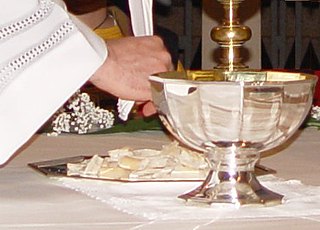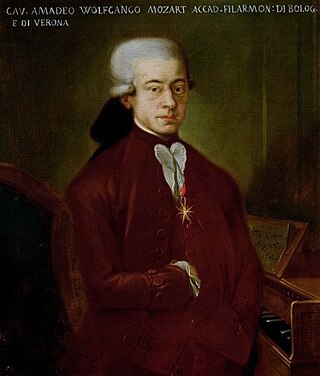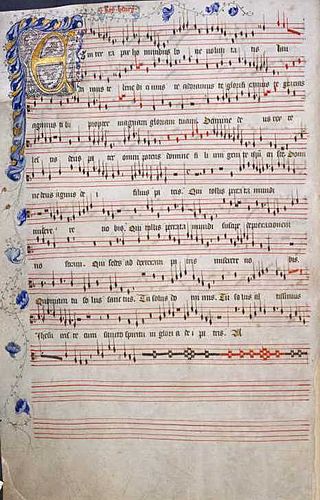Related Research Articles

The Original Chip Set (OCS) is a chipset used in the earliest Commodore Amiga computers and defined the Amiga's graphics and sound capabilities. It was succeeded by the slightly improved Enhanced Chip Set (ECS) and the greatly improved Advanced Graphics Architecture (AGA).

Agnus Dei is the Latin name under which the "Lamb of God" is honoured within Christian liturgies descending from the historic Latin liturgical tradition, including those of Roman Catholicism, Lutheranism and Anglicanism. It is the name given to a specific prayer that occurs in these liturgies, and is the name given to the music pieces that accompany the text of this prayer.

Lamb of God is a title for Jesus that appears in the Gospel of John. It appears at John 1:29, where John the Baptist sees Jesus and exclaims, "Behold the Lamb of God who takes away the sin of the world." It appears again in John 1:36.

Music hall is a type of British theatrical entertainment that was most popular from the early Victorian era, beginning around 1850, through the Great War. It faded away after 1918 as the halls rebranded their entertainment as variety. Perceptions of a distinction in Britain between bold and scandalous Music Hall and subsequent, more respectable Variety differ. Music hall involved a mixture of popular songs, comedy, speciality acts, and variety entertainment. The term is derived from a type of theatre or venue in which such entertainment took place. In North America vaudeville was in some ways analogous to British music hall, featuring rousing songs and comic acts.

"The Reeve's Tale" is the third story told in Geoffrey Chaucer's The Canterbury Tales. The reeve, named Oswald in the text, is the manager of a large estate who reaped incredible profits for his master and himself. He is described in the Tales as skinny and bad-tempered and old; his hair is closely cropped reflecting his social status as a serf. His sword is rusty while he rides a fine gray horse called Scot. The Reeve is a skilled carpenter, a profession mocked in the previous "Miller's Tale". Oswald responds with a tale that mocks the Miller's profession.

Die Schuldigkeit des ersten Gebots, K. 35, is a sacred musical play composed by Wolfgang Amadeus Mozart in 1767 when he was 11 years old. It is Mozart's first opera or, more specifically, sacred drama, as is suggested by the name. The libretto is now attributed to Ignatz Anton von Weiser, although Johann Adam Wieland or Jakob Anton Marianus Wimmer had been suggested earlier. Only the first part of the opera was composed by Mozart; the second and third parts were contributed by Michael Haydn and Anton Cajetan Adlgasser respectively. However, these other two parts have not survived. Part 1 of the opera was first performed on March 12, 1767, in the Knight's Hall of the Palace of the Archbishop, the Salzburg Residenz. Part 2 was performed on March 19, and part 3 on March 26.

Jacob Obrecht was a Flemish composer of masses, motets and songs. He was the most famous composer of masses in Europe of the late 15th century and was only eclipsed after his death by Josquin des Prez.
Leonel Power was an English composer of the late Medieval and early Renaissance music. Along with John Dunstaple, he was a dominant figure of 15th century English music. Primarily a composer of sacred music, Power is the best represented contributor in the Old Hall Manuscript.

The Old Hall Manuscript is the largest, most complete, and most significant source of English sacred music of the late 14th and early 15th centuries, and as such represents the best source for late Medieval English music. The manuscript somehow survived the Reformation, and formerly belonged to St. Edmund's College, a Roman Catholic school located at Old Hall Green in Hertfordshire. It was sold to the British Library after an auction at Sotheby's in 1973.
In Renaissance music, the cyclic mass was a musical setting of the Ordinary of the Roman Catholic Mass, in which each of the movements – Kyrie, Gloria, Credo, Sanctus, and Agnus Dei – shared a common musical theme, commonly a cantus firmus, thus making it a unified whole. The cyclic mass was the first multi-movement form in western music to be subject to a single organizing principle.
A fraction anthem is a text spoken or sung during the Christian rite of Holy Eucharist, at the point when the celebrant breaks the consecrated bread. The term is used commonly in the Episcopal Church in the United States of America. The term is an approximate translation of confractorium, a term borrowed from the Ambrosian Rite.
Estienne Grossin was a French composer of the late medieval and early Renaissance eras, active in Paris. He was one of the first composers to write a partially cyclic mass, a form which was to become the predominant large-scale vehicle for musical expression later in the 15th century.
Reginaldus Libert was a French composer of the early Renaissance. He was a minor member of the Burgundian School, a contemporary of Guillaume Dufay, and one of the first to use fauxbourdon in a mass setting.
Johannes Alanus was an English composer. He wrote the motet Sub arturo plebs/Fons citharizancium/In omnem terram. Also attributed to him are the songs "Min frow, min frow" and "Min herze wil all zit frowen pflegen", both lieds, and "S'en vos por moy pitié ne truis", a virelai. O amicus/Precursoris, attributed simply to "Johannes", may be the work of the same composer.
John Aleyn was a Canon of Windsor from 1362 to 1368 and Archdeacon of Suffolk from 1368 to 1373.

The Missa L'homme armé super voces musicales is the first of two settings of the Ordinary of the Mass by Josquin des Prez using the famous L'homme armé tune as their cantus firmus source material. The setting is for four voices. It was the most famous mass Josquin composed, surviving in numerous manuscripts and print editions. The earliest printed collection of music devoted to a single composer, the Misse Josquin published by Ottaviano Petrucci in 1502, begins with this famous work.

The Missa de Beata Virgine is a musical setting of the Ordinary of the Mass, by Renaissance composer Josquin des Prez. Though formerly believed to have been a late composition due to stylistic reasons, evidence from Burchard’s Diary proves that the mass was written sometime before September 23, 1497. It was the most popular of his masses in the 16th century.
The Missa sopra Ecco sì beato giorno is a musical setting of the Ordinary of the Mass, for 40 and 60 voices, by Florentine Renaissance composer Alessandro Striggio. It probably dates from 1565–6, during the reign of his employer, Cosimo I de' Medici. Lost for more than 400 years, it was recently rediscovered in Paris. Most of the mass is for five separate choirs of 8 voices each, with the closing Agnus Dei being for five separate choirs of 12 voices each; all of the voice parts are fully independent. With its huge polychoral forces, climaxing on sixty fully independent parts, it is the largest known polyphonic composition from the entire era.

Mass of the Children is a major work of English composer John Rutter. It is a non-liturgical Missa brevis, with the traditional Latin and Greek Mass text interwoven with several English poems.

"Christe, du Lamm Gottes" is a Lutheran hymn, often referred to as the German Agnus Dei. Martin Luther wrote the words of the hymn as a translation of the Latin Agnus Dei from the liturgy of the mass. The tune, Zahn 58, was taken from an older liturgy. The hymn was first published in 1528 and has been the basis for several musical settings by composers such as Bach, Mendelssohn and Hessenberg. It appears in modern German hymnals, both the Protestant Evangelisches Gesangbuch and the Catholic Gotteslob.
References
- ↑ Margaret Bent. "Aleyn" Archived 16 May 2008 at the Wayback Machine , Grove Music Online , ed. L. Macy (accessed May 20, 2006), (subscription access).